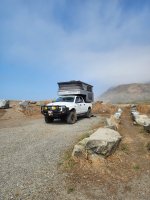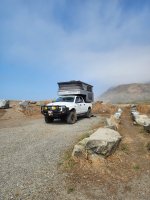@twowheels19 We've discussed it directly, but for other readers, I'll mention that STC doesn't retrofit A/C units to Flagship campers because retrofitting the wiring is a challenge. So, everyone be sure to keep that in mind when deciding on camper options. There is a non-advertised "A/C prep" package, where the A/C wiring is run but no A/C unit installed. Only with that pre-wiring package will STC add the Dometic A/C at a later date if not installed in the original build. Similar to ordering an A/C, the "A/C Prep" option will require one to decide if you want the A/C to replace the front or rear vent.
Back to batteries. 100Ah Battleborn batteries are 12.76L" x 6.86"W x 8.95"H so the 6.86" width is wider than both the batteries you mention. For a while, I had two LiTime 100Ah Smart Heated batteries in our camper. I have four of them and I planned to put in all four. Dimensions of those are 10.24"L x 6.61"W x 8.27"H so the two fit really easily in the electronic cabinet. The other two would normally fit easily in the driver's side cabinet, but I had a custom shelf bracket installed in our build so unfortunately the batteries could not slide into place. But by then, other challenges came up so I'd abandoned the use of these particular LiTime altogether. Besides the desire to expand the battery bank, the other reason I was switching to the LiTime was because the Battleborn, used for our build, were not smart batteries. Battleborn didn't even make them back then, though they do now. I wanted a battery with the bluetooth "Smart" feature so I could see details from the BMS. With non-smart batteries, one only knows what the Battery Monitor and shunt share. Usually that is good, but Battery Monitor SOC will be inaccurate when the internal battery heater uses power (since that is not registered by the shunt). When the batteries recharge after internal battery heater use, the battery monitor SOC is inaccurately high until the battery reaches a true 100% SOC again at which time the battery monitor is reset and accurate once again. I like the LiTime batteries for the price point, features, and size, but it was not all roses. I noticed peculiar behavior with the two LiTime in parallel. I'll digress from the battery dimension discussion, and elaborate, in the next paragraph.
What I'm about to describe has now been well documented for a wide range of economy LiFePO4 smart battery brands such as LiTime, Watt Cycle, etc. (though even Renogy and some "higher end" brands mention this in passing). Also, note that I mentioned smart, because the non-bluetooth enabled models do not exhibit this behavior, supposedly. Not that you'd know because you can't tell based on the terminal voltage since they are wired in parallel.
The situation is that many of these smart batteries are programmed to only draw from one battery, with small loads, when wired in parallel and all sitting at 100% SOC. The other batteries sit in "StandbyFull" mode and so do not power the load. Then, once that load-bearing battery is drawn down X volts below others (or more correctly, the terminal voltage and internal cell voltage have enough of a spread), they will wake up and share the load. There is a very technical paper, available on the Watts Cycle battery website, on why they did this (partly has to do with not wanting the battery protect circuit to kick off and on and off and on when voltage is sitting right at the trigger voltage so they turn off until there is a certain spread between the terminal voltage and the internal cell voltage, but also just some variance in internal resistance, etc.).
This sounds good on paper and the other batteries are supposed to wake up at a fairly high SOC, but in practice, the other batteries occasionally don't wake up until they are fairly low SOC and when they do, then they output current into other battery that was drawn down to a lower SOC. Though the batteries in StandbyFull mode usually connect when the active battery is still at a fairly high SOC, when they don't and the active battery is drawn to a lower SOC, this bothers my brain. And I'm not alone according to various forums and videos. But, in the big picture, probably not a huge deal as we are talking when there are light loads. And, there are work arounds such as turning on a high draw load (50+amp) which triggers draw from all batteries and all come out of StandbyFull mode. Since it doesn't trigger unless all batteries in parallel are at a very high state of charge (think 14.4v - 14.6v), some users have lowered their chargers (solar controllers, DC/DC, AC, etc.) to 13.9v to avoid the StandbyFull mode from activating. But really one could just use them as normal and move on.
Second item that wasn't all roses; I am also in the middle of a warranty claim on one of my four LiTime batteries. Seems like a cell was, or went, bad as every time it chargers to high SOC, it goes into cell balance mode for extended period of time and also disconnects and goes into "over voltage protect" mode even though I was charging to the recommended 14.4v. They sent me a shipping label, I shipped it back and am awaiting a verdict. Luckily, I had the original battleborn laying here so swapped them back into the camper. I also had two other LiTime 100Ah in my fishing boat, so could have used those if it came down to it. But, it seems like issues with LiTime are rare, so we'll see how this replacement battery does (provided they approve a replacement which is what I expect). Unless proven otherwise, I'll chalk this up to a fluke and still would buy more LiTime. As a matter of fact, I will be buying a 48v battery as part of a home backup system and will likely get a LiTime brand.
But back to fitment in various compartments. I don't have compartment dimension in front of me, but had measured for another size LiTime battery model that is 12v 165Ah and determined two of those will fit in the electronics cabinet. Those are 13.0"L x 6.77"W x 8.5"H. Narrower and barely longer than the 100ah Battleborn so seems like a great choice for way more amps in the space. Two of those would also fit over in the driver's side compartment as well for a total of four.
4 x 165ah would give you 660Ah. And that 660Ah is at the same price point as 200ah Battleborn (though I fully acknowledge there is more to it than price as some value supporting US companies even if all their components are from other countries and only assembled here). Lots of choices out there so something right for everyone.
Will be curious what other batteries folks find that fit.
I can grab some dimensions at some point, but as for the main electronics cabinet and drivers side, anything narrower than 6.88" like the battleborn is sure to fit and up to about 13" long (totally 26"), but I'll have to double check that total length mainly to ensure it leave enough room for the water valve to flip open.
Oh, another battery fitment consideration. While two 12" - 13" batteries total 24" - 26" and fit in the battery box just fine, but don't expect to be able to install a single 24" - 26" battery. I don't recall the width of the electronics cabinet opening, but that is your limiting factor on length as well as one of the three Truma heat ducts routed down in the left part of the compartment. There are some narrow, but very long, high Ah batteries that would fit once sitting in the battery box, but installing them through the electronics cabinet opening isn't possible.


